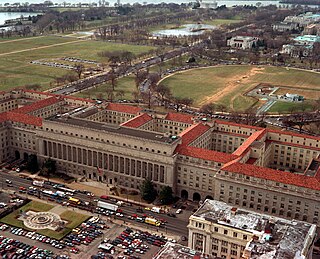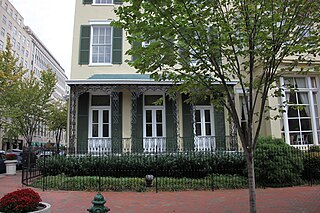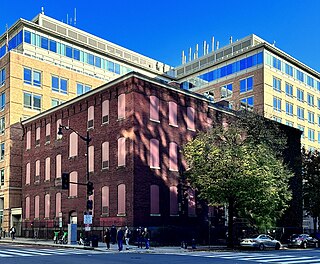
The National Building Museum is a museum of architecture, design, engineering, construction, and urban planning in Washington, D.C., United States. It was created by an Act of Congress in 1980, and is a private non-profit institution. Located at 401 F Street NW, it is adjacent to the National Law Enforcement Officers Memorial and the Judiciary Square Metro station. The museum hosts various temporary exhibits in galleries around the spacious Great Hall.

The J. Edgar Hoover Building is a low-rise office building located at 935 Pennsylvania Avenue NW in Washington, D.C., in the United States. It is the headquarters of the Federal Bureau of Investigation (FBI).

The William Jefferson Clinton Federal Building is a complex of several historic buildings located in the Federal Triangle in Washington, D.C., across 12th Street, NW from the Old Post Office. The complex now houses the headquarters of the Environmental Protection Agency (EPA).

The Kimpton Hotel Vintage Portland, historically known as the Imperial Hotel and also as The Plaza Hotel, is a historic hotel building in downtown Portland, Oregon, United States. It was completed in 1894 and was listed on the National Register of Historic Places in 1985 as "Imperial Hotel". Since 2015, the building has been in use as the Kimpton Hotel Vintage Portland, and prior to then it had been known as the Hotel Vintage Plaza since 1991.

Constitution Center, formerly known as the David Nassif Building, is an office building located at 400 7th Street SW in Washington, D.C. It is 140 feet (43 m) high and has 10 floors. Covering an entire city block, it is the largest privately owned office building in Washington, D.C. Current tenants include the Federal Housing Finance Agency and the Office of the Comptroller of the Currency. As of February 2014, Constitution Center was worth $725.8 million, making it the most valuable taxable property in the city.

Federal modernism is an architectural style which emerged in the twentieth century encompassing various styles of modern architecture used in the design of federal buildings in the United States. Federal buildings in this style shunned ornamentation, focusing instead on functional efficiency and low costs. There is no universally accepted start date for federal modernism, with some early variants of modernism emerging as early as the 1920s, but the term is most often associated with the buildings built by the U.S. General Services Administration (GSA) in the 1950s through 1970s. Prominent architects associated with federal modernism include Ludwig Mies van der Rohe, Marcel Breuer, Walter Gropius, and Victor Lundy. Federal modernism has been criticized by some architects and politicians such as Donald Trump, either because they believe it lacks "authority" or due to a perceived lack of beauty.

The Herbert C. Hoover Building is the Washington, D.C. headquarters of the United States Department of Commerce.

Kimpton Hotel Monaco Washington DC is a 183-room high end boutique hotel at the corner of 7th and F Streets Northwest in the Penn Quarter neighborhood of Washington, D.C. Kimpton Hotel Monaco DC is one of ten Kimpton hotel properties in the Washington Metropolitan Area and is located across the street from the National Portrait Gallery and the Capital One Arena. The hotel opened in the summer of 2002 and was named one of the eighty best new hotels in the world in 2003 by Condé Nast Traveler. In September 2010, Pebblebrook Hotel Trust acquired the Monaco Washington DC hotel for $74.0 million.

The Sixteenth Street Historic District is a 1.25-mile (2.01 km) linear historic district in Washington, D.C., that includes all structures along 16th Street NW between H Street and Florida Avenue. The district's southern boundary is bordered by Lafayette Square, just north of the White House, and Meridian Hill Park on its northern boundary. It includes an eclectic mix of architectural styles on one of the city's most historic and important numbered streets including single and multi-family residential buildings, embassies, hotels, churches, and office buildings.

The Byron G. Rogers Federal Building and U.S. Courthouse is a historic building on Stout Street in downtown Denver, Colorado, which serves as a courthouse of the United States District Court for the District of Colorado. Completed in 1965, the building was renamed for Colorado Congressman Byron G. Rogers in 1984. In 1996 and 1997, the criminal case against bomber Timothy McVeigh was conducted there. Additionally, the federal building is home to 11 federal agencies, including the United States Patent and Trademark Office's new Rocky Mountain Regional location that opened on June 30, 2014. The building was listed on the National Register of Historic Places in 2016.

The U.S. General Services Administration Building is a historic office building and the headquarters of General Services Administration located at Washington, D.C. It was built originally to house offices of the United States Department of the Interior.

The Old Post Office, listed on the National Register of Historic Places as the Old Post Office and Clock Tower, is located at 1100 Pennsylvania Avenue, N.W. in Washington, D.C. It is a contributing property to the Pennsylvania Avenue National Historic Site. The building's 315-foot (96-meter) high clock tower houses the "Bells of Congress," and its observation level offers panoramic views of the city and its surroundings. A historic federal office building, it now serves as a hotel.

The United States Tax Court Building is a courthouse located at 400 Second Street, Northwest, Washington, D.C., in the Judiciary Square neighborhood. It serves as the headquarters of the United States Tax Court. Built in 1972, the building and its landscaped plaza occupy the entire block bound by D Street, E Street, Second Street, and Third street.

The Harry S Truman Building is the headquarters of the United States Department of State. It is located in Washington, D.C., and houses the office of the United States secretary of state.

The Cutts–Madison House is an American colonial-style historic home, now used for offices located at 1520 H Street NW in Washington, D.C. The house is best known for being the residence of former First Lady Dolley Madison, who lived there from November 1837 until her death in July 1849.
Vlastimil Koubek was an American architect who designed more than 100 buildings, most of them in the Washington metropolitan area, and whose total value topped $2 billion. Most of his work is Modernist in style, although he developed a few structures in other vernaculars. He created the site plan for the redevelopment of Rosslyn, Virginia, and his Ames Center anchored the area's economic recovery. He designed the World Building in Silver Spring, Maryland, which sparked redevelopment of that town's downtown; and the L'Enfant Plaza Hotel in Washington, D.C. In 1985, Washingtonian magazine called him one of 20 people "who in the past 20 years had the greatest impact on the way we live and who forever altered the look of Washington." In 1988, The Washington Post newspaper said his Willard Hotel renovation was one of 28 projects in the area that made a signal contribution to the "feel" and look of Washington, D.C.

The Hotel Washington is a historic hotel located at 515 15th Street NW in downtown Washington, D.C.

The James V. Forrestal Building is a low-rise Brutalist office building in Washington, D.C. Originally known as Federal Office Building 5, and nicknamed the Little Pentagon, the Forrestal Building was constructed between 1965 and 1969 to accommodate United States armed forces personnel. It is named after James Forrestal, the first United States Secretary of Defense. It became the headquarters of the United States Department of Energy after that agency's creation in 1977.

Appleton Prentiss Clark Jr. was an American architect from Washington, D.C. During his 60-year career, Clark was responsible for designing hundreds of buildings in the Washington area, including homes, hotels, churches, apartments and commercial properties. He is considered one of the city's most prominent and influential architects from the late 19th and early 20th centuries. Many of his designs are now listed on the National Register of Historic Places (NRHP).

The Webster School, also called the Daniel Webster School, is a historic building located at 940 H Street NW in Washington, D.C. Built in 1882 as a segregated school for white children, it was among a large number of brick schools constructed in the city after the Civil War. These schools were located a couple of blocks from each other, allowing class sizes to be small. Most of the schools were two-story buildings, but some were larger and three stories. The Webster School was one of those larger schools.





















